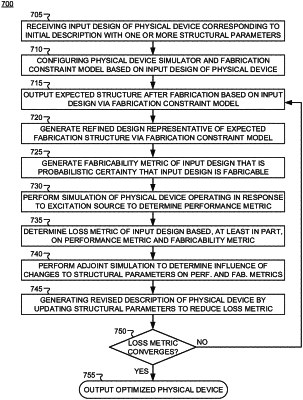| CPC G06F 30/20 (2020.01) [G06N 3/045 (2023.01); G06N 3/084 (2013.01); G02B 5/0268 (2013.01); G06F 30/23 (2020.01); G06F 30/27 (2020.01); G06F 2111/04 (2020.01); G06F 2119/18 (2020.01); G06F 2119/22 (2020.01); Y02P 90/02 (2015.11)] | 16 Claims |

|
1. A method for optimizing a design of a physical device, the method comprising:
receiving an input design of the physical device corresponding to an optical or electromagnetic device, wherein the input design is an initial description of the physical device defined by structural parameters;
performing a simulation of the physical device operating in response to an excitation source to determine a performance metric of the physical device based on the input design of the physical device and the excitation source;
generating a fabricability metric of the input design via a fabrication constraint model, wherein the fabricability metric is related to a probabilistic certainty that the input design is fabricable by a fabrication process, wherein generating the fabricability metric comprises:
generating a simulated post-fabrication image representative of the input design fabricated by the fabrication process by inputting the input design into a fabrication model included in the fabrication constraint model; and
inputting the post-fabrication image into a neural network included in the fabrication constraint model to generate the fabricability metric, wherein the neural network is trained to classify the input design as fabricable or not fabricable with the fabrication process;
determining a loss metric of the input design based on a loss function that incorporates the performance metric and the fabricability metric;
performing an adjoint simulation by backpropagating the loss metric through a simulated environment as an adjoint source to determine a contribution of changes to the structural parameters on the loss metric;
generating a revised description of the physical device by updating the structural parameters to reduce the loss metric based on the contribution of changes; and
fabricating the physical device based on the revised description using the fabrication process.
|